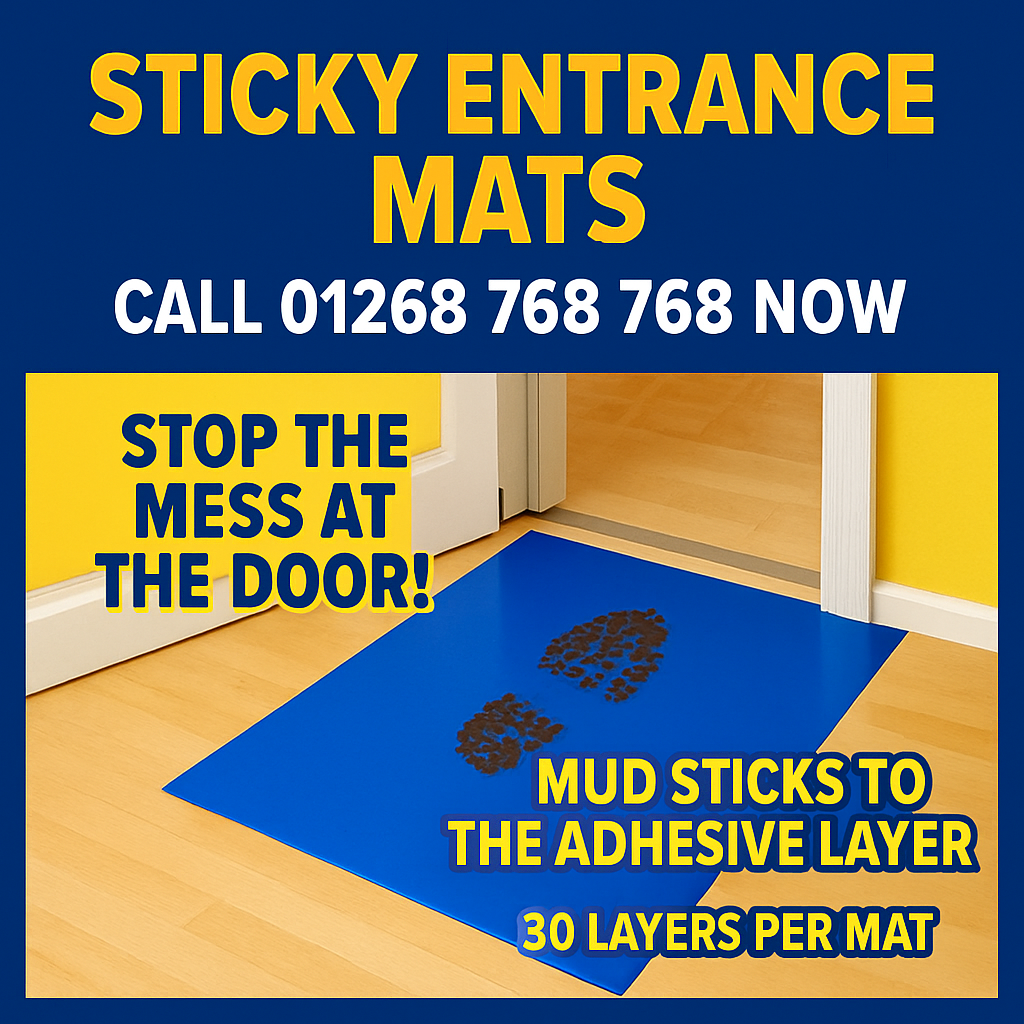Attention all builders! If you're tired of mucky footprints turning your work site into a costly clean-up zone, you've come to the right place. Every construction project, renovation, or fit-out comes with its own unique set of challenges, but one constant headache is the battle against dirt, dust, and debris. It gets everywhere, tracked from room to room on the soles of work boots, damaging new floors and creating a professional nightmare.
Keeping a site clean isn't just about appearances; it's about protecting your hard work, maintaining a safe environment, and keeping clients happy. Uncontrolled foot traffic can lead to scratched hardwoods, stained carpets, and hours of wasted labour on cleaning. This is where a simple yet incredibly effective solution comes into play: sticky mats.
These aren't your average doormats. We’re talking about high-performance adhesive mats designed to grab dirt and dust right at the door. When walked on, the tacky surface pulls contaminants from footwear, stopping the mess before it starts. This guide will walk you through everything you need to know about using these indispensable tools to maintain cleanliness and professionalism on any job site. Say goodbye to mucky footprints and hello to pristine floors.
What Are Sticky Entrance Mats?
Sticky mats, also known as tack mats or adhesive floor mats, are pads with multiple layers of adhesive-coated film. Each sheet is designed to capture dirt, dust, and other small particles from the soles of shoes, trolley wheels, and equipment. When a layer becomes saturated with dirt, you simply peel it off to reveal a fresh, clean sheet underneath. It's a brilliantly simple system for effective contamination control mats.
The concept originated in cleanroom environments, like those found in electronics manufacturing, pharmaceuticals, and laboratories, where even the smallest speck of dust could compromise products or experiments. These cleanroom mats proved so effective at trapping contaminants that their application quickly expanded.
Today, they are a staple in a wide range of industries, especially construction and renovation. Builders and decorators recognised that the same technology used to protect sensitive microchips could also protect a newly installed hardwood floor or a freshly laid carpet. The result is a powerful tool for entrance protection that is both easy to use and highly efficient.
At Indigo Supplies, we've been providing industrial solutions since 1998, and we've seen first-hand how these mats can transform a work site. They are a small investment that delivers a huge return by preventing damage, reducing cleaning costs, and enhancing your professional image.
The High Cost of Uncontrolled Foot Traffic
Mucky boots might seem like a small issue on a busy construction site, but the costs associated with uncontrolled dirt and debris can quickly add up. These expenses aren't just financial; they can impact your timeline, client relationships, and professional reputation.
Financial Costs of Clean-Up
The most obvious cost is the labour required for cleaning. Whether you're paying your own team to down tools and pick up mops or hiring a professional cleaning crew, those hours represent a direct hit to your project's profitability. A final clean-up is expected, but constant, daily cleaning to manage tracked-in dirt is an unnecessary drain on resources.
Furthermore, dirt and grit act like sandpaper underfoot. When tracked across newly installed surfaces, they can cause irreversible damage:
- Scratched Flooring: Hardwood, laminate, vinyl, and tile floors are all susceptible to scratches from small stones and grit caught in the treads of work boots. Repairing or replacing a damaged section of flooring is far more expensive than preventing the damage in the first place.
- Stained Carpets: Dust, mud, and oils can quickly ruin a brand-new carpet. Deep cleaning may not always be successful, potentially forcing a costly replacement.
- Contaminated Paintwork: Dust kicked up from floors can settle on wet paint or finishes, resulting in a gritty, unprofessional texture that requires sanding and repainting.
Wasted Time and Project Delays
Every minute spent on unnecessary cleaning is a minute not spent on the actual build. These delays can have a domino effect, pushing back subsequent stages of the project and extending the overall timeline. In a world where time is money, these inefficiencies can be incredibly costly. Delays can also lead to penalty clauses being invoked by clients, further eroding your profit margin.
Damage to Your Professional Reputation
Your work site is a direct reflection of your company's standards. A client visiting a site covered in dust and tracked-in mud may question your team's attention to detail and professionalism. Conversely, a clean and organised site signals competence, respect for the client's property, and a commitment to quality.
A pristine finish at handover is non-negotiable. If a client discovers scratches on their new floor or stains on their carpet, it can lead to difficult conversations, disputes over the final payment, and negative reviews. A positive reputation is one of your most valuable assets, and maintaining a clean site is a simple way to protect it. Using construction entrance mats shows foresight and a commitment to excellence that clients will notice and appreciate.
How to Choose the Right Sticky Mat for Your Site
With various options available, selecting the right tacky floor mats for your project is crucial. The choice depends on the specific environment, the level of foot traffic, and the types of contaminants you need to control. Here’s a breakdown of what to consider.
Size and Placement
The first rule of entrance mats is that they need to be large enough to be effective. A mat that is too small can be easily sidestepped, rendering it useless. For optimal performance, the mat should be large enough to capture at least two steps from each person entering the area. This ensures that both feet make contact with the adhesive surface.
Consider the main entry and exit points of your work area. These are the primary locations for your mats. You might also place them at the entrance to particularly sensitive areas, such as a room with newly installed flooring or a space that has just been painted. For high-traffic areas, placing two sticky floor mats end-to-end can provide even better coverage.
Number of Layers
Our disposable mats come with multiple peel-off layers, typically 30 or 60 sheets per mat. The number of layers determines how long the mat will last before you need to replace the entire pad.
- For Short-Term Projects: A mat with 30 layers may be sufficient for a smaller job or a project lasting only a few weeks.
- For Long-Term Projects: On a larger, longer-term construction site with heavy foot traffic, a 60-layer mat offers better value and convenience, as it will require less frequent replacement.
Think about the conditions on your site. If it's particularly dusty or muddy, you may be peeling off layers more frequently, making a higher-count mat a more economical choice.
Adhesive Strength
The "tackiness" of the mat is what makes it work. Our mats are engineered with a specially formulated adhesive that is strong enough to pull dirt and dust from shoe soles but not so strong that it sticks to the shoes themselves or leaves a residue. This balance is key to their effectiveness.
For most construction environments, a standard-tack mat is ideal. It effectively captures common construction site debris like sawdust, drywall dust, and soil. In more specialised settings, such as healthcare or electronics, mats with different tack levels might be available, but for general building use, our standard adhesive mats are the perfect fit.
Frame or No Frame?
You can use disposable sticky mats in two ways:
- Directly on the Floor: The back of the mat pad has an adhesive layer that secures it directly to a hard, clean surface like concrete, tile, or vinyl. This is the most common and straightforward method of use.
- With a Reusable Frame: For use on surfaces where direct adhesion isn't possible, such as carpet, a rigid frame with a non-slip backing is available. You place the mat inside the frame, which holds it securely in place. Our Heavy Duty Cotton Tack Mat and Frame is a great example of a robust, reusable solution.
Choosing the right mat is a simple process once you assess your site's needs. If you're unsure which option is best for you, our team at Indigo Supplies is always here to help. Give us a call, and we can guide you to the perfect entrance protection solution.
Your Next Steps for a Cleaner Site
Keeping a construction site clean is a challenge, but with the right tools, it becomes significantly more manageable. Sticky step mats offer a simple, effective, and professional solution to stop dirt and debris at the door, protecting your work and your reputation.
By investing in high-quality construction sticky mats, you are taking a proactive step to:
- Avoid Costly Clean-Ups: Reduce the labour hours and expenses associated with cleaning tracked-in dirt.
- Protect Finished Surfaces: Prevent scratches, stains, and damage to new floors, carpets, and other surfaces.
- Enhance Professionalism: Demonstrate a commitment to quality and respect for your client's property.
- Improve Site Safety: Reduce the amount of dust and debris in the air and on the floors, creating a healthier work environment.
Since 1998, Indigo Supplies has been a trusted partner for businesses across the UK, providing a huge range of industrial products backed by expert advice. We pride ourselves on our 5-star service and our price beater guarantee—if you find the same product cheaper elsewhere, we'll do our utmost to beat it.
Ready to stop the mess and elevate the standard of your work sites? Explore our full range of disposable tacky mats and other floor protection solutions. Our team is ready to help you find the perfect product for your needs.
Don't let mucky boots undermine your hard work. Click here to buy sticky mats now or call us on 01268 768 768 for more information. Let's get the job done, cleanly and professionally.

